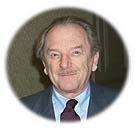 Solar electricity may seem like a gift from the Gods, but in fact it was an invention of man (perhaps God inspired), and it is not new. The photovoltaic (PV) effect was discovered in 18th century France, promoted by Germany's Werner von Siemens, and developed as a workable product by our own Bell Labs in 1954. But it was pioneers like Peter Varadi, with the appropriate initials "PV," who created the modern solar PV industry. (In this blog I'll occasionally profile solar leaders, but only those I've had the privilege of knowing personally.)
Solar electricity may seem like a gift from the Gods, but in fact it was an invention of man (perhaps God inspired), and it is not new. The photovoltaic (PV) effect was discovered in 18th century France, promoted by Germany's Werner von Siemens, and developed as a workable product by our own Bell Labs in 1954. But it was pioneers like Peter Varadi, with the appropriate initials "PV," who created the modern solar PV industry. (In this blog I'll occasionally profile solar leaders, but only those I've had the privilege of knowing personally.)
Dr. Varadi was legendary when I first consulted for Solarex Corp. in Maryland in the late 1980s, and I always wanted to meet him. It wasn't until the mid-90s that I discovered he lived in the apartment building next door to mine in Chevy Chase. We met, became friends, and I learned first hand a good deal about the early history of solar electricity. A chemistry graduate of a Hungarian university, where he earned his PhD, Dr. Varadi escaped from his homeland just as the Russians invaded to crush the Hungarian revolution in 1956. A great gain for the U.S., as he went to work for COMSAT in Maryland researching the hand-made, expensive solar cells that powered satellites.
Solarex process reduced cost - made solar practical
In 1973 he and fellow physicist Joe Lindmeyer decided solar power could be brought "from space to Earth" by bringing down the costs. So they founded a Maryland company called Solarex to industrialize the manufacturing of polycrystalline silicon solar cells using their own patented process. They turned these cells into solar modules (commonly called "solar panels") on a mass-production basis, dramatically reducing the costs.
Solar powers the Third World and remote locations
I asked Peter what motivated him, and he said it was the dream of using solar not just to power satellites but to bring electricity to remote communities. He told me he first saw solar modules powering mountain homes in Spain, which in turn convinced him to open a half dozen factories in Europe. Soon Solarex became the world's largest solar company, and was selling solar by the megawatt for all kinds of "remote power applications." In 1990 Solarex (before I knew Peter) gave me a small grant to start the non-profit Solar Electric Light Fund (SELF) to bring solar rural electrification to developing countries. We bought Solarex modules whenever we could to electrify thousands of rural homes.
In 1983 Amoco (formerly Standard Oil of Indiana, now part of BP) bought Solarex and Peter retired, but not really. He undertook to form a standards and certification organization for solar cells and modules called PV Gap, for "PV Global Approval Program." Today he's working on a non-technical book about "human side" of PV and consulting for the World Bank on low cost solar lights for developing countries.
Solarex solar panels still going strong
In 1999 British Petroleum (BP) bought Amoco and thus inherited Solarex, which they merged with their own BP Solar, setting up it's world headquarters in Frederick, Maryland. Today, from the Interstate just outside Frederick, MD, you can see the monument to these two great unsung American entrepreneurs, Peter Varadi and the late Joe Lindmeyer: it's the original slab-roofed Solarex plant covered with cobalt blue solar modules, still generating power 25 years later to help "breed" the production of 100 megawatts of silicon solar cells a year.
